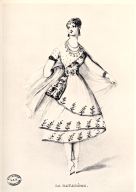 19th c. Femininity
19th c. Femininity
While the Restoration of the Bourbon Monarchy in 1815 saw the return of the natural waistline, qualities of weightlessness continued to speak to the ideals of femininity through the use of light-weight fabrics. As well, white, pink and flesh tones dominated the colour schemes of this era, calling up the surface quality of the marble statues of antiquity. This was true for tights as well as dresses, an increasingly important element of feminine garb. Since the skirts of the new republic were slightly shorter, tights covered the leg for propriety’s sake and extra warmth but also had the effect of giving flesh the statuesque appearance of white marble (Chazin-Benhaum 1997). Charles Baudelaire makes this allusion, discussing the purpose of tights:
"
…
designed to rid the complexion of those blemishes that Nature has outrageously
strewn there, and thus…create an abstract unity in color and texture
of the skin, a unity which, like that produced by the legs of a dancer,
immediately approximates the human being to the statue, that is to something
superior and divine" (Baudelaire
1964, p. 33).